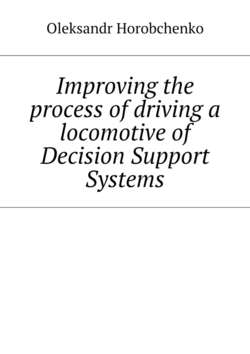Improving the process of driving a locomotive of Decision Support Systems

Реклама. ООО «ЛитРес», ИНН: 7719571260.
Оглавление
Oleksandr Horobchenko. Improving the process of driving a locomotive of Decision Support Systems
1. Introduction
2. Literature review and problem statement
3. The aim and tasks of the study
4. Methods and tools for designing locomotive decision support systems
4. 1. Structure and architectural hierarchy of DSS for locomotive crews
4. 2. Formalization of fuzzy situations in the process of train driving
4.3. The models that simulate decision making processes
4.4. Methods of decision making of locomotive DSS under conditions of uncertainty of the input data
4. 5. Determining a current state of train as a control object
4. 6. The basics of the system of self— learning of intelligent locomotive DSS
4. 7. Development of mathematical model of dynamic knowledge base
5. Discussion of results of research into intelligent locomotive DSS
6. Conclusions
Отрывок из книги
The functioning of the ergatic system “train – locomotive driver” is conditioned by a number of factors, the main of which are the quality and timeliness of decision-making. Gradually the systems of driving a locomotive are developing in the direction of decreasing the role of locomotive crews in the process of driving the train, which allows reducing harmful influence of the human factor on the safety and effectiveness of the operation of rolling stock. The final stage of this development will be a transition to a fully automated control of trains.
At present, “the human factor” in operating a locomotive still plays a significant role and reduces transportation safety. This is illustrated by the accident that happened in Spain in 2013, where the accident involving a high-speed train occurred as a result of exceeding the speed by the driver, 80 people died and more than 140 were injured. Over the period from 2011 to 2015, 130 people throughout the world were killed as a result of the railway accidents caused by locomotive brigades [1]. Thus, the problem of improving the quality of driving decisions that a driver takes is relevant and requires further development of theoretical principles of its solution.
.....
At present, “the human factor” in operating a locomotive still plays a significant role and reduces transportation safety. This is illustrated by the accident that happened in Spain in 2013, where the accident involving a high-speed train occurred as a result of exceeding the speed by the driver, 80 people died and more than 140 were injured. Over the period from 2011 to 2015, 130 people throughout the world were killed as a result of the railway accidents caused by locomotive brigades [1]. Thus, the problem of improving the quality of driving decisions that a driver takes is relevant and requires further development of theoretical principles of its solution.
An analysis of the scientific literature leads to the conclusion that the modern development of the theory of systems of driving a locomotive, the software and the element base does not allow achieving a fully autonomous motion of trains. A transition stage to the unmanned locomotive driving is the implementation of intelligent locomotive decision support systems. At present, theoretical framework for the implementation of this task is not sufficiently developed. Such issues as the definition of the structure of a locomotive intelligent system, development of mathematical apparatus for describing fuzzy situations when driving a locomotive, and modeling the process of the system’s self-learning have not been studied enough. Left unaddressed is the question of development of dynamic knowledge bases for locomotive decision support systems.
.....